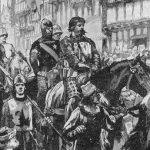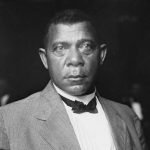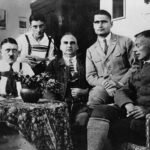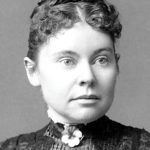Althea Gibson was born in 1927 in Carolina, her parents were poor and their livelihood was under threat. As cotton pickers they received a small percentage of the profits for their labour but America was in the grips of a savage drought and for three consecutive years the crops failed forcing them to uproot their small family.
Althea was three when her parents moved her to their new home in Harlem, coming from a rural existence to a bad neighbourhood wasn’t the ideal, but a person does what they have to do to survive. Her father took on odd jobs and found work as a handy man but times were tough and he raised his little girl to be a fighter, teaching her to box and defend herself from an early age.
Recommended Reading
FREEDOM! The Real Life and Death of Sir William Wallace
Who was Grigori Rasputin? The Story of the Mad Monk Who Dodged Death
Diverse Threads in the History of the United States: The Life of Booker T. Washington
Her parents were strict but that didn’t seem to faze the strong willed Althea. She never really fitted in at school and surrounded by poverty, she quickly lost hope in the system. Althea started bunking school and got into trouble with the law, she lacked direction and a healthy outlet for her excess energy. Her deviant behaviour and lack of respect for school and authority figures landed her in hot water and she was heading toward reform school at the tender age of ten.
“Never give up on a child”
Althea was by no means the only kid in her area headed down the wrong track and the police took it upon themselves to start a sports programme aimed at teaching kids a bit of responsibility.
On a make shift paddle court, set up in the court yard outside her parents flat, Althea stood and listened to Buddy Walker explain the rules. For the first time she felt a twinge of excitement, the racket felt good in her hands and as she threw the ball up ready to make her first underhand serve her whole life changed. No longer would she be Althea Gibson the problem child, she would be Althea the child prodigy. She would play for hours on the court, daring people to challenge her. Two years later she won her first championship and was crowned the Paddle Tennis Champion of New York – the first of many titles.
Althea Gibson finally found something she was good at and the people around her noticed her talent and dedication, Buddy Walker took her down to the Harlem Cosmopolitan club and introduced her to tennis. She played her first game against the club champ and amazed everyone watching. Rhoda Smith was in the stands that day and saw Althea’s talent for the sport. Rhoda and Buddy took her under their wing, tennis wasn’t a cheap sport but with their help she managed to get the right clothes and equipment and even her first junior membership and an opportunity to be coached.
READ MORE: Who Invented Tennis? Exploring the History Behind the Game’s Creation
Althea Gibson walked onto the tennis court in 1941, she was 14 years old, it was a warm summer’s day in New York. She had been playing tennis for just over a year and yet stood in front of a crowd preparing to serve for the African American New York State Tennis Champion Title. Althea was ruthless on the court, spared the privileged upbringing of most involved with the sport she brought a raw energy never seen before. Each point was as if it was a life or death dual fought between serves and volleys, each point won pushing her to fight harder and keep her advantage and as the dust on centre court settled a new champion was crowned. She would go on to win the tournament another 6 times between 1944 and 1949.
“No matter what accomplishment you make, somebody helped you”
Rhoda and Buddy were the first of many who would see Althea’s passion and talent. By the age of 18 they had groomed her into an accomplished player but she needed more, Althea Gibson had a gift for the game and surpassed her coach’s ability to guide her on the next step of her Journey. Two surgeons proactive in developing the game noticed her at the ATA championships, they offered her free board and the opportunity to train full time while completing her high school.
Althea jumped at the opportunity, practising 8 hours a day, seven days a week. She worked hard and it paid off on both the tennis court and in her academics, Althea finished in the top ten of her class and was awarded a scholarship for college and in 1946 she managed to win her first National ATA championship, something that had alluded her until now. Althea Gibson would go onto defend this title successfully for the next ten years dominating the African American circuit.
Althea was at the top of her game and had her sights set on world domination, her lack of direction replaced with a burning desire to be the best and thanks to the people who believed and mentored her it all seemed possible.
“I don’t consciously beat the drums for any cause, not even the Negro in the United States.”
Althea Gibson was the best and knew it, but she was a black woman born into a world where the colour of your skin determined your place in life. Her attempts to enter matches falling under the control of the United States Lawn Tennis Association were futile, they had a strict white’s only policy and slammed the door in her black face. Althea was not fighting for equal rights, nor was she trying to break down the walls of segregation, her fight was not political, her desire was selfish – Althea wanted to play the best players to prove she was the best regardless of race, colour or creed.
In July 1950 Alice Marble wrote a historical letter, “If Althea Gibson represents a challenge to the present crop of woman players, it is only fair that they should meet the challenge on courts.” Alice’s letter went on to call the association, a group of sanctimonious hypocrites. Her letter managed to hit a nerve and people started to question a ranking system that excluded ethnic groups.
Latest Biographies
Queen Zenobia: The Charismatic Empress of Ancient Syria
Eleanor of Aquitaine: A Beautiful and Powerful Queen of France and England
Frida Kahlo Accident: How a Single Day Changed an Entire Life
In August on 1950, Althea entered the gated community surrounding Forest Hills, the Tudor style club house towered above her. She had made it, she was finally going to get the chance to prove to the world who she was.
Her opponent was Denise Brough, the current world champion. The crowd stood jeering insults as she stepped onto the court, but Althea managed to block them out. She fought hard and was ruthless leading the world champion in a tie breaker. The energy was electric and the championship was within her grasp. Suddenly the clouds pulled over and the heavens cried, Althea stood in disbelief as bolt of thunder smashed into the bronze eagle on the roof knocking it off its pedestal. She had come so far, fought so hard, only to be denied. The match was postponed and Althea lost her upper hand, the pressure of having to complete the match the following day weighed heavily on her nerves. Surrounded by reminders of the “white game” she entered to face her opponent once again, unable to hold her nerve she lost the final set a midst a sea of white and jeering insults. But what she lacked in results she gained in admiration, her skill and bravery had won over the fans.
“From 143rd Street in Harlem to the center court in Wimbledon is about as far as one can travel.”
In 1956 Althea Gibson was invited to play at Wimbledon an event she had aspired to her entire life and even though racial tension brewed in the states, she looked set for world domination. As she stood in the center court, her heart raced all she could do to steady her nerves was concentrate on destroying her competition. The match proved to be too much for her though, narrowly losing in the final round of the woman’s singles. She went on to play in the doubles final with Angela Buxton and the two woman thrashed their competition.
This victory gave her the confidence and her narrow loss fuelled her desire to come back twice as hard, setting the stage for what she called the year of her life. In 1957 she toured around the world wining championship match after championship match. But she could never let her guard down, she was still a black woman in a sea of white. When she stepped out onto the court regardless of where it was in the world the crowds would cheer for her white opponent to beat her, she used this to fuel her rage and played a ruthless game of tennis, wearing down and tiring out her opponents before finally crushing them. Althea would walk away vindicated while her opponent reeled in the bitter taste of defeat.
By the time she walked down the hallowed passage leading out to center court, Althea had come a long way and was no longer the nervous Negro girl entering Forest Hills, she exuded confidence and her opponents were intimidated by her standoff personality and aggressive style of play. Wimbledon would be her ultimate challenge, she knew if she won Wimbledon she would be that much closer to being crowned the Queen of tennis. Althea didn’t seem to care who her opponent was all she wanted to do was beat them and not even the presence of the Queen of England could intimidate her, this was her year and it was her turn to shine, she broke her opponents serve and fought hard for every point, the years of tireless practice had paid off and she smashed her way to the converted title, driven by the desire to be the best in the world.
“Being a champion is all well and good, but you can’t eat your crown”
Althea Gibson returned to Wimbledon and successfully defended her title the following year, but the life of a ‘tennis bum’ was financially taxing, there were no endorsements and players only received a small sum to cover their expenses whilst on tour. She was crowned the Queen of tennis but reigned over an empty bank account and when she returned home at the end of the season was forced to make a difficult decision.
Having achieved fame but not the fortune, Althea retired from the tennis circuit after winning 56 national and international tiles and started pursuing more financially viable ventures. Turning professional she played exhibition matches for the Harlem globe trotters, released an album and even made it to the big screen acting in a Western movie alongside John Wayne. But what surprised her many sports fans was her adaptability and seeing an opportunity to make some money she started playing golf.
Althea not only broke through the boundaries of one elitist sport but two and became the first professional Female African American golfer. Although she never achieved the same success on the golf course, it goes without saying that just being there was a remarkable achievement.
Althea went on to coach women’s sport in the early 70’s and later worked for Department of Recreation and served on the State Athletics Board before becoming a supervisor of the Governor’s Council on Physical Fitness.
“I always wanted to be somebody.”
Althea always had a strong will to be the best and rose to meet every challenge, she didn’t always win but she got back up and made sure she came back even stronger. It important to take a few moments to step into her shoes and look at the obstacles she fought so hard to overcome.
Althea was a black woman born into a world dominated by racial segregation and sexist views, yet she never protested or used it as an excuse for failure. She accepted the challenge and rose above those who wished to supress her.
One can scarce imagine the guts it took to walk out onto the court, the first black woman to stand on the hallowed ground of Forest Hill, breaking every boundary with silent rebellion and a steady hand and even after all her success, she was still denied the basic respect and rights afforded to her white opponents. Forced to leave the venue after winning a match, having to change in her car as she was banned from the white’s only locker rooms and club houses. Her drive to be the best pushed her beyond what most would endure.
Fame does not always mean fortune and for the best part of Althea’s life she lived month to month, afraid to get sick or turn down an invitations to play. Being seen as a novelty and used to attract crowds, her accomplishments on the courts were a bitter sweet victory and, she never managed to attain the same financial worth as the white players she ruthlessly thrashed. Althea was forced on numerous occasions to validate her desire to play tennis in a world that clearly wasn’t ready for her.
Althea was a force to be reckoned with and took everything in her stride, even in her bleakest times she never failed to inspire those around her as she smashed down the walls that tried to contain her wild and unrelenting spirit. She opened the doors for so many black woman and has been sighted as an inspiration by the Williams sisters who decades later followed in her footsteps.
Althea Gibson died in 2003, her later life marred by arthritis and debilitating strokes. The Queen of tennis had ruled the world, but became destitute eventually needing to ask for assistance to cover her ever growing medical bills. Her once athletic frame confined to a wheelchair, the greatest tennis player became a shadow of her former self but her heart and passion never wavered.
Explore More Biograhies
Diverse Threads in the History of the United States: The Life of Booker T. Washington
Sir Moses Montefiore: The Forgotten Legend of the 19th Century
Beer Hall Putsch: Causes, Outcomes, and Hitler’s Rise to Power
America’s Favorite Little Darling: The Story of Shirley Temple
Erwin Rommel: Life, Achievements, and Death of the Famous Desert Fox
Lizzie Borden
Althea Gibson’s legacy continues to inspire girls all around the world and she has been fondly remembered in numerous documentaries and motion pictures about her life. For her accomplishments on the court she was inducted into both the International Tennis Hall of Fame and the International Women’s Sports Hall of fame. Althea was also the first woman to receive the NCAA Theodore Roosevelt Award. She is hailed as a pioneer for breaking down the barriers of segregation in sports and is honoured by numerous Black History movements both in the states and around the world. Althea was the first African American woman to be feature on the covers of both Times Magazine and Sports Illustrated. For the role she played in developing the sport and making it more accessible to previously disadvantaged players she was honoured in with a bronze statue in New Jersey just outside the courts where she coached.
Althea Gibson managed to not only become someone, she became someone worth remembering and paying tribute to.











Most informative, easy to read, and well researched.
It’s nice to know there are still some good people out there like you that care and have a passion for what you are doing. .Good luck and keep up the good work.